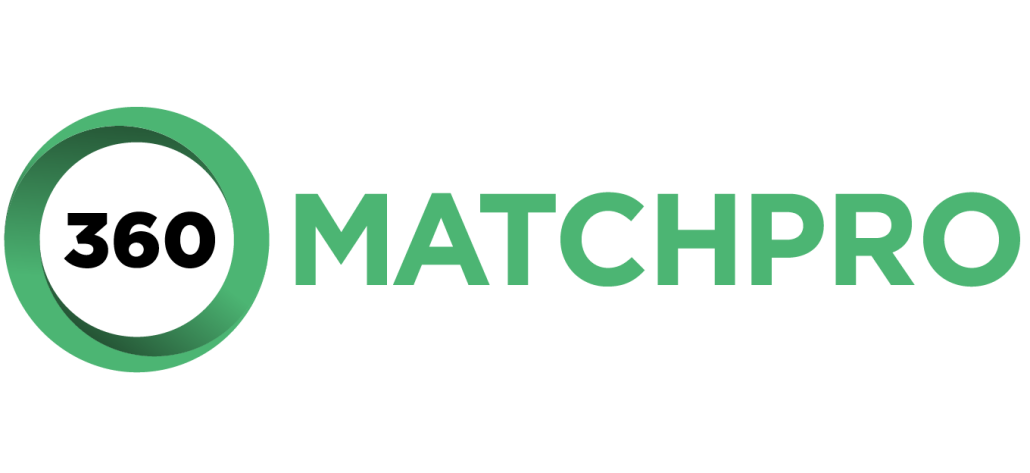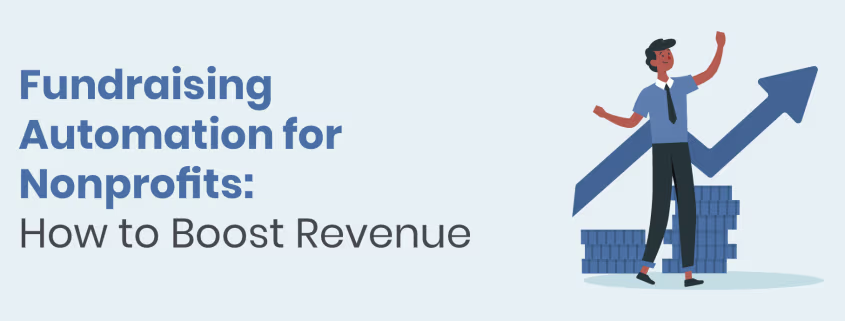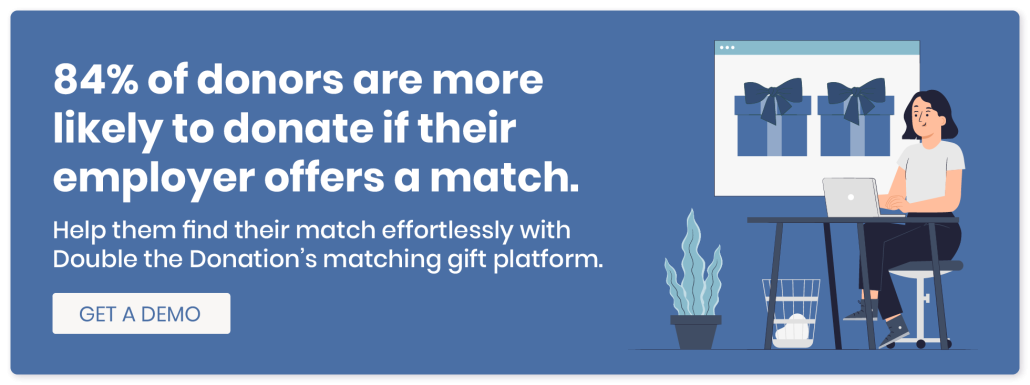Fundraising Automation for Nonprofits: How to Boost Revenue
Integrating technology into your nonprofit’s daily workflow allows you to achieve more for your mission in less time. Fundraising automation is a useful technological advancement for modern nonprofits, allowing you to free up time and resources for mission-critical activities like sending supporter communications and promoting matching gifts.
However, many nonprofits continue to do manual tasks that could be automated with the right software. That’s why it’s important to take inventory of your efforts regularly to see which tasks can be easily streamlined and find a software solution to help.
In this guide, we’ll share everything a nonprofit fundraiser needs to know about automation strategies, including:
Ready to dive in with an overview of fundraising automation, the advantages of these tactics, and various types of automation to leverage? Let’s begin with the basics.
Fundraising Automation for Nonprofits: FAQs
What is fundraising automation for nonprofits?
Fundraising automation is when software automatically executes tasks once certain criteria are met. The goal is for the technology to independently manage tasks on the nonprofit’s behalf, saving time, money, and staff resources.
For example, a donor conducting Task A (such as donating) might trigger a series of responses from the nonprofit, such as the following:
- Within five minutes of the donation being made, the donor receives a tax-deductible donation receipt in their inbox.
- Within 12 hours of the donation being made, the donor receives a personalized gift acknowledgment email thanking them for their specific contribution.
- Within 24 hours of the donation being made, the donor receives a targeted matching gift follow-up email with eligibility criteria specific to their employer.
- Within 90 days of the donation being made, the donor receives a customized fundraising appeal for a repeat donation slightly larger than their initial gift.
A well-programmed software solution can automate any number of fundraising tasks, from sending segmented marketing messages to collecting volunteer signups. We’ll review some common uses for fundraising automation in a later section.
Who benefits from fundraising automation?
Simply put, everyone has something to gain from fundraising automation, especially these stakeholders:
- Nonprofits: Many nonprofits run on limited budgets and resources. Fundraising automation is one of the best ways to take some menial tasks off your team’s plates, allowing them to do more with their time and see a larger return on their efforts.
- Donors: When an organization manually manages donation follow-ups and thank-you communications, some individuals will likely fall through the cracks. On the other hand, fundraising automation removes multiple opportunities for human error, ensuring each donor is prioritized as an equal player in the nonprofit’s mission—all in a timely manner.
- Beneficiaries: When nonprofits can tackle previously time-consuming tasks with new technology solutions, team members will have more time and energy to devote to mission-focused tasks. Not to mention, many organizations raise even more money through automated fundraising, which will direct additional dollars toward your constituents’ needs.
What are the common challenges associated with fundraising automation?
At face value, numerous factors of fundraising automation might make your team hesitant to try it, such as:
- Loss of personalization. Fundraising requires personalized, emotional appeals to be successful. Using software to automate fundraising processes can seem risky on the off chance that it removes a human touch from communications.
- Cost of implementation. Depending on the software’s complexity and your team’s tech experience, it can be challenging and time-consuming to incorporate it into your workflows.
- Integration complexities. Automation software needs to integrate with the rest of your software to access all your important data. Finding solutions that integrate seamlessly adds another step to your implementation checklist.
That said, the benefits of fundraising automation far outweigh the drawbacks. Plus, there are many ways that you can avoid these pitfalls and have an advantageous relationship with automation:
- Prioritize personalization. Write all of your messages yourselves. Then, you can configure your automation software to conduct other processes, such as sending out the communications once they’re written or pulling contact information for certain segments.
- Develop a clear budget and implementation timeline. By laying these details out early on, you can pick a solution that aligns with your needs. Consider choosing software with extensive support resources included or build in the cost of working with a tech consultant so you can get up and running quickly.
- Choose a solution that has extensive integration options. Pick an automation software solution that easily integrates with your tech stack, such as your CRM or marketing management platform. This ensures that important information doesn’t slip through the cracks and that you maintain full control over your data.
6 Best Uses of Fundraising Automation for Nonprofits
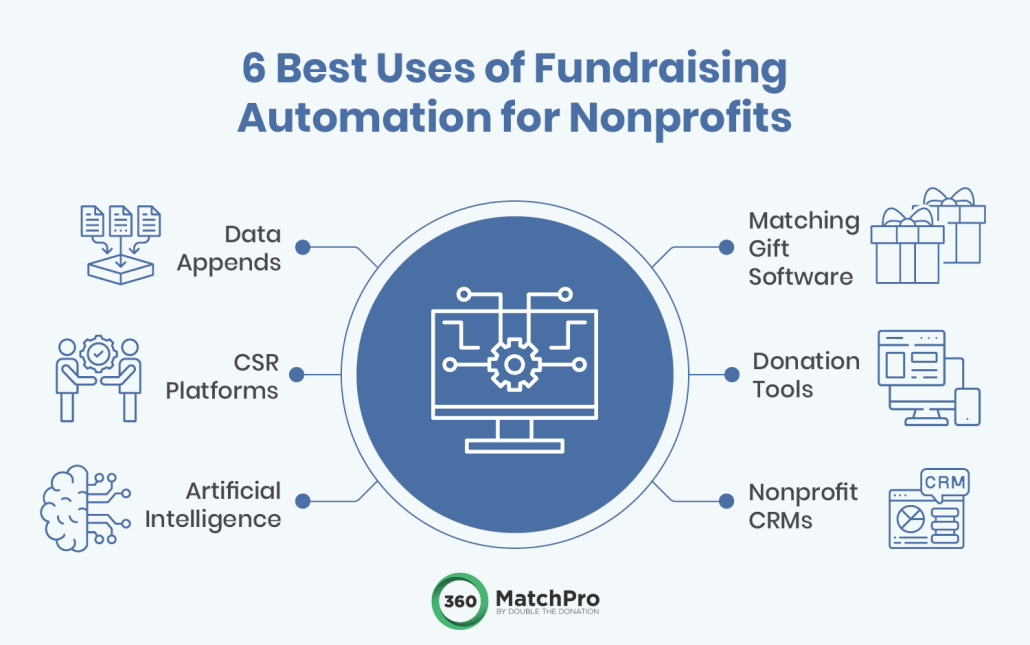
Even if you’re a total beginner to fundraising automation, you’re probably familiar with some of the most basic types of automated efforts and the tools that power them. Let’s review the top uses of fundraising automation for nonprofits.
Matching Gifts
Corporate matching gifts are one of the most powerful yet continually underutilized sources of nonprofit funding. In fact, approximately $4 to $7 billion in available match revenue goes unclaimed each year.
The most common roadblocks to matching gift optimization are a lack of awareness of these programs and a poor understanding of the submission process among match-eligible donors. However, matching gift fundraising automation can mitigate and even eliminate these issues for nonprofits with auto-submission.
Here’s how matching gift auto-submission works:

- An individual donor contributes directly to a nonprofit on the organization’s website.
- The donor enters their corporate email address and potentially one other field to submit their match automatically.
- Our software automatically completes the match request process on their behalf.
It’s really that simple! Auto-submission removes over half of the typical matching gift submission stages, simplifying the process for donors and securing more gifts for your nonprofits.
Want to learn more about matching gift auto-submission? Check out our educational video to get started:
Donation Tools
The best management solutions incorporate automation into many channels, such as your website, text-to-give platform, and CRM. Automating donation processes simplifies giving and encourages supporters to donate.
You’re likely to see automation at play in the following areas:
- Recurring gift management. Many online donation tools enable nonprofits to automatically process and record recurring donations. In these cases, individuals schedule regularly repeating donations that are then transferred to the organization according to the agreed-upon timeline.
- Donation reminders. If your supporters haven’t set up recurring gifts yet, you can use automation to remind them to participate in your campaign, especially if it’s on a timeline. For example, you might send reminders to ask fundraisers to support your GivingTuesday campaign before the day ends.
- Impact metrics. As your nonprofit puts donations to use, you can send your supporters updates for funds or projects they’ve supported.
When it comes to donation tools, finding a solution that encrypts donor information is crucial. Ensure that your automation software is PCI-compliant, allowing you to send important communications without leaking sensitive data.
Nonprofit CRMs
Your CRM is likely the crux of your nonprofit’s tech stack, so leveraging its automation features can greatly transform your workflow.
The most important automated process your CRM should be capable of is form population and data storage. As a donor completes an online donation form, for example, they often provide key details such as their name, contact information, employment status, donation amount, and more. A nonprofit’s CRM is typically connected to its donation tools to pull the information it needs in a neat, automated manner.
Your CRM then automatically fills in the blanks, effectively turning this:
Dear [Donor’ preferred name], thank you for your generous donation of [donation amount] to our [fundraiser participated in] campaign!
Into this:
Dear Janet, thank you for your generous donation of $300 to our school supply drive campaign!
A CRM should also assist your nonprofit in segmenting its donors into lists based on shared characteristics for further targeted communications. This allows nonprofits to send different (and more relevant) messages to their small, mid, and major donors—all without manually sorting contacts.
Data Appends
The more a nonprofit knows about its donors, the better its communications, relationships, and overall fundraising will be. However, cultivating interpersonal supporter relationships requires access to contact information, wealth data, employment details, and other demographics.
So what if your organization doesn’t have this information for every supporter? While you might be able to enlist team members to scour the internet for insights on donors and prospects, automating the process is quicker, simpler, and more effective.
That’s where data appends come in!
In general, a data append refers to the process of supplementing an existing dataset with new information. When it comes to fundraising, the operation is generally performed as a way to update supporter records with additional information to guide an organization’s engagement strategies.
Let’s take matching gifts, for example. Your matching gift software can’t identify match-eligible donations if you don’t know where your donors work. While you can (and should) request the information from donors within the giving proces itself, collecting that data through employer appending services is an effective way to fill in the gaps and secure any employment data you currently lack.
Imagine you know an individual’s name, email address, engagement history, and alma mater, but not the company they work for. In that case, you’d supply the information you do have to an established data appending service. A data appending software would then scan the record against a combination of publicly available and privately held resources to locate the missing pieces of data: the individual’s employer (and matching gift eligibility).
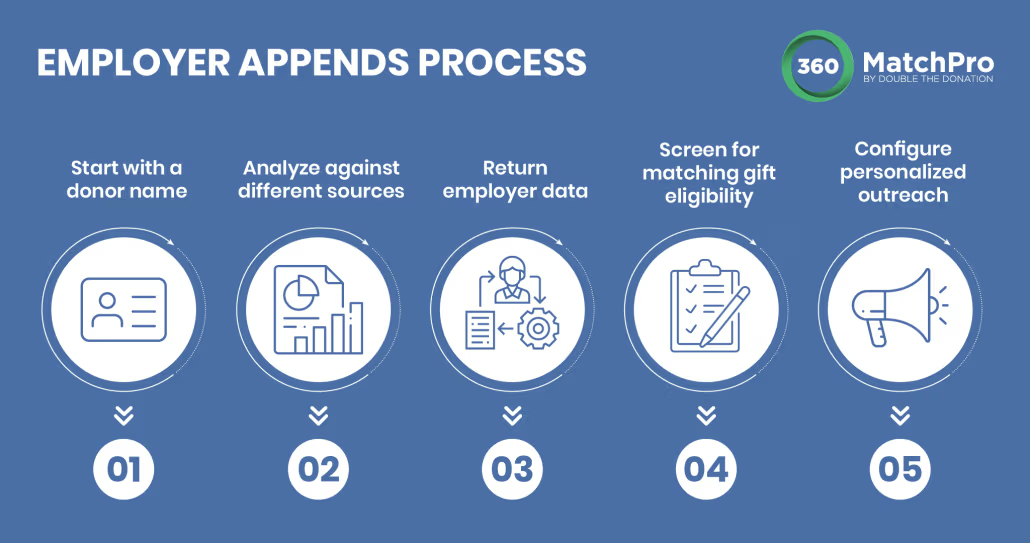
From there, you have what you need to configure increasingly personalized outreach and tailor your matching gift communications to the recipient. You can even provide company-specific program guidelines and links to online request forms to simplify the submission process!
CSR Platforms
We covered nonprofit matching gift software, which streamlines the process of informing donors about matching gift programs and directing them to their employers’ matching gift submission forms. But what happens from each company’s perspective?
Thousands of companies use various CSR management platforms to facilitate matching gift programs. In these scenarios, your organization’s matching gift software (such as Double the Donation) directs donors to a company’s online match request portal. The donor provides essential donation information to fulfill the request, and they submit their match.
Unfortunately, a potential roadblock comes into play when companies require nonprofits to verify individual donations. However, nonprofits can streamline this process by pre-registering with top CSR platforms. When these software providers already have a nonprofit listed as a verified cause, it enables them to automate the verification of employee gifts easily, getting more matches approved in a timely manner.
Artificial Intelligence
Artificial intelligence, or AI, is generally seen as an advancement in machinery that enables technology to conduct tasks typically reserved for human minds. Thus, the idea of AI has become particularly beneficial to nonprofit fundraising efforts thanks to the ability to automate donor engagements while maintaining a personal flair.
In particular, AI can automate the following processes for your nonprofit:
- Ask curation. Many platforms are beginning to leverage artificial intelligence to analyze everything the organization knows about an individual (such as their previous donations, engagement history, wealth level, and more) to curate the “perfect” donation size to include in online giving forms.
- Chatbot support. Human team members aren’t always available to answer your supporters’ questions quickly. Adding an AI chatbot to your website gives your supporters a 24/7 source of information that dynamically adapts based on their request, boosting satisfaction and increasing the likelihood of them giving.
- Volunteer management. Creating the perfect volunteer schedule can feel like a balancing act. AI can quickly determine when to schedule volunteers based on their skills and availability, saving your team headaches and preventing human error.
To get started with AI, pick a software provider that offers integrated, user-friendly AI tools. Then, train your team and let your supporters know how to use it. AI for nonprofits is a win-win, because your supporters get quicker answers while your nonprofit can push objectives forward faster.
Fundraising Automation for Nonprofits: Final Thoughts & Additional Resources
Leveraging fundraising automation is one of the best ways to streamline your organization’s efforts and retain more time and resources for mission-focused tasks—all without allowing your donor relationships to suffer.
Effective automation begins by equipping your nonprofit team with the right tools. Make sure you have best-in-class donation tools and CRMs, but don’t stop there. Ensure you’re ready to make the most of your fundraising with matching gifts, data appends, CSR platforms, artificial intelligence, and more.
Dive deeper into top-of-the-line fundraising software, tips, and tricks with our other educational resources:
- What is a Data Append and Why Does it Matter for Nonprofits? Data appends can greatly improve your nonprofit’s reach and fundraising success. Learn more about appending missing donor data and how your nonprofit can get started.
- How Donor Employer Information Boosts Fundraising + Workplace Giving. Having ample, accurate, and up-to-date information on your nonprofit’s donors is essential. This guide explores how donor employer information can elevate your fundraising efforts.
- Matching Gift Databases: What Nonprofits Should Know in 2024. Equipping your team with the right matching gift database can play a significant role in matching gifts and overall fundraising automation. Learn more about this tool and how it can help.
